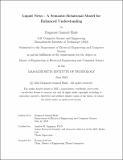| dc.contributor.advisor | Lippman, Andrew B. | |
| dc.contributor.author | Haile, Dagmawi Samuel | |
| dc.date.accessioned | 2023-07-31T19:38:34Z | |
| dc.date.available | 2023-07-31T19:38:34Z | |
| dc.date.issued | 2023-06 | |
| dc.date.submitted | 2023-06-06T16:35:14.131Z | |
| dc.identifier.uri | https://hdl.handle.net/1721.1/151422 | |
| dc.description.abstract | The landscape in which society interacts with news has evolved due to the advent of the internet and modern communication platforms. Although this evolution has led to greater diversity and accessibility of news media, it has also created challenges regarding selective news coverage, bias, and fake news. This work proposes a novel news platform called Liquid News that aims to enhance people’s understanding of news by leveraging machine-learning-based analysis and semantic navigational aids. Semantic segmentation and unsupervised clustering are the core machine-learning tasks underpinning Liquid News. Thus far, many state-of-the-art (SoTA) large language models provide building blocks for both tasks. However, more research needs to be done on combining large language models and their application to analyzing video news. Liquid News addresses this domain gap by intersecting semantic segmentation, unsupervised clustering, and video processing in application to video news. Furthermore, Liquid News investigates solutions to overcoming the challenges of anisotropy in semantic embedding and clustering of text. | |
| dc.publisher | Massachusetts Institute of Technology | |
| dc.rights | In Copyright - Educational Use Permitted | |
| dc.rights | Copyright retained by author(s) | |
| dc.rights.uri | https://rightsstatements.org/page/InC-EDU/1.0/ | |
| dc.title | Liquid News - A Semantic-Relational Model for
Enhanced Understanding | |
| dc.type | Thesis | |
| dc.description.degree | M.Eng. | |
| dc.contributor.department | Massachusetts Institute of Technology. Department of Electrical Engineering and Computer Science | |
| mit.thesis.degree | Master | |
| thesis.degree.name | Master of Engineering in Electrical Engineering and Computer Science | |
